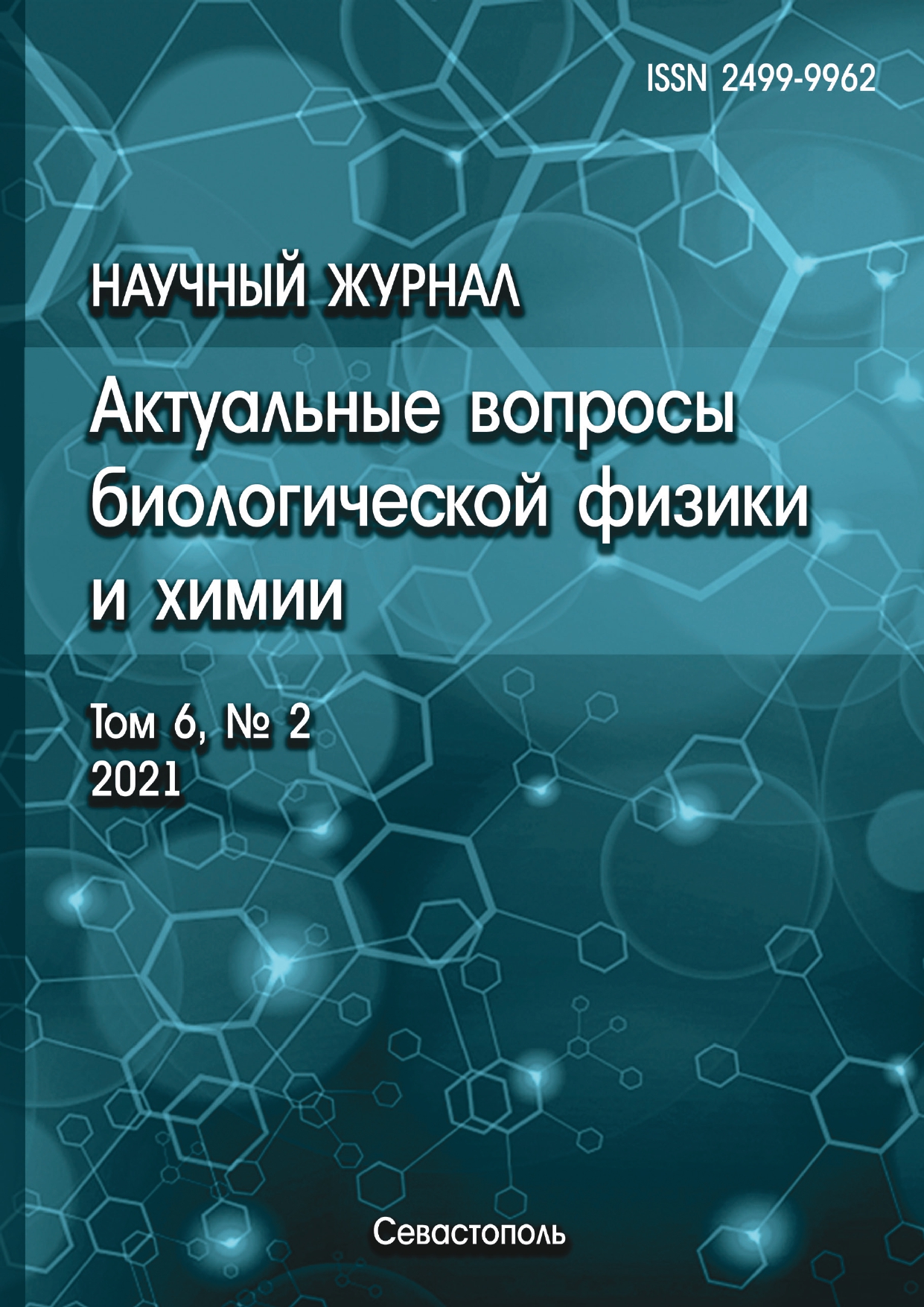Moscow State Academy of Veterinary Medicine and Biotechnology - MVA by K.I. Skryabin
Russian National Research and Technological Poultry Farming Institute, RAS
Moscow, Moscow, Russian Federation
Moscow, Moscow, Russian Federation
Moscow, Moscow, Russian Federation
By means of highly sensitive and specific enzyme sensor it was shown, that most of living tissues contain less than 50-100 nM of nitrite and nitrosamines and up to tens of μM of NO donors - S-nitrosothiols (RSNO), dinitrosyl iron complexes (DNIC) and high molecular weight nitrocompounds, that can turn to DNIC (RNO2). This fact means that living tissues can prevent NO oxidation to produce toxic compounds. NO donors - are stable compounds and they are not spontaneously decomposed with free NO release. The main pool of NO donors in most tissues is represented by DNIC. NO can transfer from the complex to the target at the moment of the complex destruction under the action of more effective iron chelators than the ligands of the DNIC. The transition is carried out with a minimum stay of NO in the free state. If the complex is exposed to an effective iron chelator, but there is no target, an iron-nitrosyl complex containing this chelator is formed. We assume, that some parts of the apoenzymes of NO targets can play the role of competitive chelators. Therefore, the physiological effect of NO donors depend not on their ability to produce free NO, but on the presence and characteristics of the physiological target. Not free NO accidentally finds the target, but the target, interacts with the NO donor causing its destruction and attaching NO. The effectiveness of DNIC as NO donor also depends on the DNIC structure and the ligand type. DNIC containing ligands with a high affinity for iron is more difficult to destroy by an iron chelator, which is necessary for the transfer of NO to the target. These effects were demonstrated both in model systems and living organisms.
nitric oxide, dinitrosyl iron complexes (DNIC), DNIC ligands
1. Vanin A., Borodulin R., Mikoyan V. Dinitrosyl iron complexes with natural thiol-containing ligands in aqueous solutions: Synthesis and some physico-chemical characteristics (A methodological review). Nitric Oxide., 2017, vol. 66, pp. 1-9. doi:https://doi.org/10.1016/j.niox.2017.02.005. EDN: https://elibrary.ru/YVCPNT
2. Vanin A. Dinitrosyl iron complexes with thiol-containing ligands as a "working form" of endogenous nitric oxide. Nitric Oxide, 2016, vol. 54, pp. 15-29. doi:https://doi.org/10.1016/j.niox.2016.01.006 EDN: https://elibrary.ru/WWALVD
3. Hickok J.R., Sahni S., Shen H., Arvind A., Antoniou C., Fung L.W., Thomas D. Dinitrosyliron complexes are the most abundant nitric oxide-derived cellular adduct: biological parameters of assembly and disappearance. Free Radic. Biol. Med., 2011, vol. 51, no. 8, pp. 1558-1566. doi:https://doi.org/10.1016/j.freeradbiomed.2011.06.030 EDN: https://elibrary.ru/PGWEDT
4. Tarpey M., Wink D., Grisham M., Methods for detection of reactive metabolites of oxygenand nitrogen: in vitro and in vivo considerations. American Journal of Physiology-Regulatory Integrative and Comparative Physiology, 2004, vol. 286, pp. R431-R444. doihttps://doi.org/10.1152/ajpregu.00361.2003. EDN: https://elibrary.ru/KNFIAU
5. Titov V., Osipov A. Nitrite and Nitroso Compounds can serve as Specific Catalase Inhibitors. Redox Rep, 2017, vol. 22, no. 2, pp. 91-97. doi:https://doi.org/10.1080/13510002.2016.1168589. EDN: https://elibrary.ru/WUDHKR
6. Titov V. The Enzymatic Technologies Open New Possibilities for Studying Nitric Oxide (NO) Metabolism in Living Systems. Current Enzyme Inhibition, 2011, vol. 7, no. 1, pp. 56-70. doi:https://doi.org/10.2174/157340811795713774. EDN: https://elibrary.ru/OIAEVH
7. Severina I., Bussygina O., Pyatakova N., Malenkova I., Vanin A. Activation of soluble guanylate cyclase by NO donors--S-nitrosothiols, and dinitrosyl-iron complexes with thiol-containing ligands. Nitric Oxide, 2003, vol. 8, pp. 155-163. doi:https://doi.org/10.1016/s1089-8603(03)00002-8 EDN: https://elibrary.ru/LHUNSP
8. Titov V.Y., Kosenko O.V., Starkova E.S., Kondratov G.V., Borkhunova E.N., Petrov V.A., Osipov A.N. Enzymatic Sensor Detects Some Forms of Nitric Oxide Donors Undetectable by Other Methods in Living Tissues. Bull Exp Biol Med., 2016, vol. 162, no. 1, pp. 107-110. doi:https://doi.org/10.1007/s10517-016-3557-1. EDN: https://elibrary.ru/ESVYKL
9. Titov V.Yu., Petrenko Yu.M., Petrov V.A., Vladimirov Yu.A. Mehanizm okisleniya oksigemoglobina, inducirovannogo perekis'yu vodoroda. Byull. eksper. biol. med., 1991, tom 112, № 7, s. 46-49. @@Titov V., Petrenko Yu., Petrov V., Vladimirov Yu. Mechanism of oxyhemoglobin oxidation induced by hydrogen peroxide. Biull Eksp Biol Med., 1991, vol. 112, no. 7, pp. 46-49. (In Russ)
10. Titov V., Dolgorukova A., Fisinin V., Borkhunova Ye., Kondratov G., Slesarenko N., Kochish I. The role of nitric oxide (NO) in the body growth rate of birds. World Poultry Science Journal, 2018, vol. 74, pp. 675-686. doi: org/10.1017/S0043933918000661 EDN: https://elibrary.ru/YBVKGL
11. Stalmer J., Singel D., Loscalzo, J. Biochemistry of nitric oxide and its redox-activated forms. Science, 1992, vol. 258, pp. 1898-1902. doi:https://doi.org/10.1126/science.1281928. EDN: https://elibrary.ru/BMOZYX
12. Rossig L., Fichtlscherer B., Breitschopf K., Haendeler J., Zeiher A., Mulsch A., Dimmeler S. Nitric oxide inhibits caspase-3 by S-nitrosation in vivo. J. Biol. Chem., 1999, vol. 274, no. 11, p.6823-6826. doi:https://doi.org/10.1074/jbc.274.11.6823. EDN: https://elibrary.ru/LQHOLZ
13. Dimmeler S., Haendeler J., Nehls, M., Zeiher A. Suppression of apoptosis by nitric oxide via inhibition of interleukin-1beta-converting enzyme (ICE)-like and cysteine protease protein (CPP)-32-like proteases. J. Exp. Med., 1997, vol. 185, no. 4, pp. 601-607. doi:https://doi.org/10.1084/jem.185.4.601.
14. Kim Y-M., Chung H-T., Simmons R., Billiar T. Cellular non-heme iron content is a determinant of nitric oxide-mediated apoptosis, necrosis, and caspase inhibition. J. Biol. Chem., 2000, vol. 275, no. 15, pp. 10954-10961. doi:https://doi.org/10.1074/jbc.275.15.10954. EDN: https://elibrary.ru/LQVAXD
15. Schopfer F., Baker P., Giles G., Chumley Ph., Batthyany C., Crawford J., Patel R., Hogg N., Branchaud B., Lancaster J., Freeman B. Fatty acid transduction of nitric oxide signaling. Nitrolinoleic acid is a hydrophobically stabilized nitric oxide donor. J. Biol. Chem., 2005, vol. 280, no. 19, pp. 19289-19297. doi:https://doi.org/10.1074/jbc.M414689200
16. Lima E., Bonini M., Augusto O., Barbeiro H., Souza H., Abdalla D. Nitrated lipids decompose to nitric oxide and lipid radicals and cause vasorelaxation. Free Radic. Biol. & Med., 2005, vol. 39, no. 4, pp. 532-539. doi:https://doi.org/10.1016/j.freeradbiomed
17. Forman H., Zhang H., Rinna A. Glutathione: Overview of its protective roles, measurement, and biosynthesis. Mol. Aspects Med., 2009, vol. 30, no. 1-2, pp. 1-12. doi:https://doi.org/10.1016/j.mam.2008.08.006










